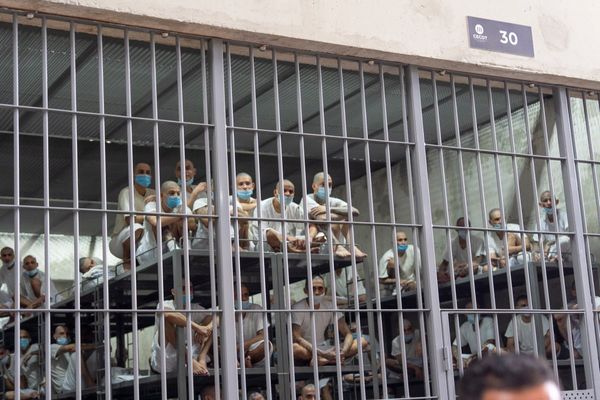
Set in post-apocalyptic Dhaka, Nuhash Humayun’s Moshari became the first Bangladeshi film to qualify for the Oscars last year. The spine-tingling thriller follows two sisters and their fight for survival, but for the film’s co-producer, Bushra Afreen, the horror fiction felt closer to reality.
“There was so much that resonated with my own experiences,” says Afreen, who grew up in Bangladesh, which has long been on the frontline of the climate crisis. “Our film was about many things, including a metaphor for how climate change can rob women and girls of their childhood and innocence, and push them into survival mode.”
With temperatures in Asia rising at twice the global average rate, Afreen must now cope with the effects of extreme heat in her home city, Dhaka, the capital of Bangladesh. Since the film’s premiere, she has taken on a new role, the first of its kind in Asia: chief heat officer for Dhaka North.

The 30-year-old joins an all-female network of heat officers in cities around the world, including Miami; Athens; Melbourne; Chile’s capital, Santiago; Freetown in Sierra Leone; and the Mexican city of Monterrey.
Her appointment is part of an initiative led by the Atlantic Council’s Adrienne Arsht-Rockefeller Foundation Resilience Center (known as Arsht-Rock) to help city administration departments coordinate their response to extreme heat and better protect their residents.
Chief heat officers are tasked with accelerating heat-protection efforts and initiating new work to reduce the risks and impact of the changes.
“Every year, extreme heat is responsible for more deaths across the globe than any other climate hazard,” says Afreen, who previously worked as a social welfare executive at her family’s garment business, where she helped to set up a taskforce to reduce heat on factory production floors.
This year, temperatures in Dhaka hit 40.6C (105F) – the highest in six decades – leading to a rise in hospital admissions and at least 20 deaths, though this is likely to be an underestimate.
“Accurate data is difficult to come by,” says Afreen. “That’s certainly the case for Dhaka. But I am working with the city’s health officials to get a better understanding of the effects of extreme heat on people’s health.”
Scientists believe global warming has made such heatwaves at least 30 times more likely for Bangladesh and India. “Dhaka has always been hot but now the dangers posed by heatwaves are much more acute,” says Afreen.

“Between climate change and rapid urbanisation, we have ended up with rising temperatures and very few green spaces and shade to provide relief from the heat.”
Green spaces are a significant component of urban planning that are often overlooked in Bangladesh. A recent study found that spaces such as parks, urban woodland and other vegetation – crucial for controlling temperatures in a city – have shrunk by 66% over the last three decades in Dhaka North City Corporation, where Afreen’s father, Atiqul Islam, is mayor.
North Dhaka is particularly vulnerable to the urban heat-island effect due to its densely populated city centre, with some urban hotspots more than 10C (18F) higher than the surrounding countryside. With the number of dangerously hot days a year estimated to double by 2050, the impacts of extreme heat in Dhaka will also intensify.
Bangladesh’s crowded capital is estimated to be home to more than 23 million people, with approximately 2,000 more people a day arriving. Many have migrated from rural villages after being forced to leave their homes due to other climate disasters; two-thirds of Bangladesh is less than 5 metres (15ft) above sea level (with about 10% of the country only 1 metre above it), and the rising ocean and heat-amplified cyclones have already claimed hundreds of thousands of hectares of land.

Jewel Ahmed, 27, migrated from Barishal to Dhaka a year ago, and spends more than 10 hours a day in the searing heat, ferrying passengers around in his rickshaw.
“It’s unbearable,” he says. “You can’t afford to miss a day’s work in this city so we just have to keep going, whatever the weather.”
During the recent heatwave, he started waking before sunrise to work, taking a break during the hottest part of the day, and working again in the evening.
“This city isn’t built for people like us,” he says. “There aren’t enough trees along the roads so we are dangerously exposed throughout the day.”
One of the initiatives Afreen is working on is an urban greening project, which involves planting 200,000 trees over two years, including within slums, or “informal settlements”, where poorer communities generally suffer the most from extreme heat.
As heat and humidity increases with climate change, it is expected to double heat-related pressures on labour productivity in Bangladesh and could threaten the country’s economic development.
“Extreme heat cost Dhaka 8% of its economic output in 2020 and without adaptation measures, this number will grow,” says Afreen. Dhaka is unusually vulnerable due to its labour-intensive economy and low rate of cooling measures.
Arsht-Rock analysis suggests that under the current climate conditions in Dhaka, 20% of outdoor working hours are lost to heat each year, which could increase to 24% by 2050.
Low-income workers are particularly vulnerable. Hazera Khatun, 48, works as a waste recycler and is exposed to dangerous heat and fumes all day long. During the recent heatwave, she fainted three times in one week.
“I had to take time off as I felt too weak to carry on,” she says. “My family really struggled that week.”

Khatun lives in Korail, Dhaka’s largest slum, bordering Gulshan and Banani, two of Dhaka’s most affluent neighbourhoods. “Only the rich can afford to bear this heat,” says Khatun.
“We have no air conditioning and our tin hut becomes so hot during the day, you can burn your hand touching it. The water pipes also heat up so we can’t even take cold showers.”
Afreen says there are more than 100 “water ATM booths”, where people can get cheap drinking water, in north Dhaka, which she is looking to expand across the city.

She also wants to create a “cool map” to help citizens access the nearest water booth or cooling centre – temporary air-conditioned spaces set up to offer respite from the heat when temperatures rise to dangerous levels.
However, expanding infrastructure takes time, and the magnitude and increasing severity of the problem in Dhaka calls for a rapid scaling-up of efforts to protect the city’s residents and economy.
As temperatures continue to rise, as in so many places across the world, women in Bangladesh may bear the disproportionate burden of heat’s devastating physical, social, and financial effects.
“An unequal share of unpaid work makes it harder for women in the informal sector to access or succeed in the labour market, leading to lower productivity and lower salaries,” says Afreen.
“Extreme heat is also contributing to a rise in gender-based violence and severe health issues for women.”
Protective and preventive actions that safeguard women are urgently needed. “When we understand the impacts of extreme heat and invest in gender-informed solutions, only then can we build toward a cooler, more equitable future – especially for women and girls,” says Afreen.







